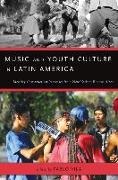Read more
Informationen zum Autor Pablo Vila's research focuses on the social construction of identities on the U.S.- Mexico border and in Latin America. He has researched issues of national, regional, racial, ethnic, religious, gender, and class identities on the U.S.- Mexico border and has published 5 books on the topic. In his work on identification processes in Latin America, he has researched the way differentsocial actors use popular music to understand who they are and act accordingly. He has published 4 books on that topic. Klappentext This book examines the ways in which music is used to advance identity claims in several Latin American countries and among Latinos in the US. Drawing on a vast array of fields including popular music studies, ethnomusicology, sociology, and history it sheds new light on the complex ways in which music provides people from different countries and social sectors with both enjoyment and tools for understanding who they are in terms of nationality, region, race,ethnicity, class, gender, and migration status. Zusammenfassung Music is one of the most distinctive cultural characteristics of Latin American countries. But, while many people in the United States and Europe are familiar with musical genres such as salsa, merengue, and reggaeton, the musical manifestations that young people listen to in most Latin American countries are much more varied than these commercially successful ones that have entered the American and European markets. Not only that, the young people themselves often have little in common with the stereotypical image of them that exists in the American imagination. Bridging this divide between perception and reality, Music and Youth Culture in Latin America brings together contributors from throughout Latin America and the US to examine the ways in which music is used to advance identity claims in several Latin American countries and among Latinos in the US. From young Latin American musicians who want to participate in the vibrant jazz scene of New York without losing their cultural roots, to Peruvian rockers who sing in their native language (Quechua) for the same reasons, to the young Cubans who use music to construct a post-communist social identification, this volume sheds new light on the complex ways in which music provides people from different countries and social sectors with both enjoyment and tools for understanding who they are in terms of nationality, region, race, ethnicity, class, gender, and migration status. Drawing on a vast array of fields including popular music studies, ethnomusicology, sociology, and history, Music and Youth Culture in Latin America is an illuminating read for anyone interested in Latin American music, culture, and society....

